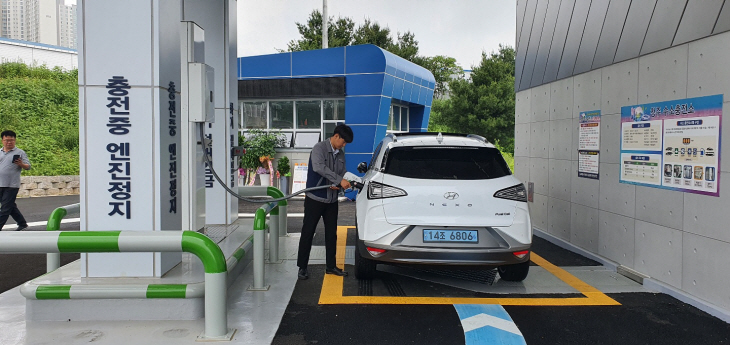
|
|
▲ At the hydrogen charging station, charging is being done for Nexo hydrogen cars. |
[에너지경제신문 김연숙 기자] From tomorrow, the safety management completion training, which was mandatory for general hydrogen vehicle drivers, will be exempted. While double-layer installation of hydrogen charging stations is permitted, safety management will be strengthened for low-pressure hydrogen facilities at the same level as high-pressure hydrogen facilities from August.
The Ministry of Trade, Industry and Energy announced that the’Amendment to the High-Pressure Gas Safety Management Act Enforcement Regulations’ including the above contents was promulgated and that it will be implemented in earnest from the 26th.
In the meantime, for hydrogen cars, not only regular drivers such as vehicle owners, but also one-time drivers such as short-term or surrogate drivers and rental car drivers must receive safety training. Penalties have been imposed for failure to complete education. However, with the abolition of the LPG vehicle driver safety training in 2018, requests for improvement of related systems have been raised for reasons such as equity.
Accordingly, the government excluded general passenger car drivers such as the Nexo among the hydrogen vehicles from the safety training, but improved the hydrogen bus drivers used by a large number of unspecified vehicles to receive safety training as they are now.
Instead, it plans to include the safety management of hydrogen vehicles in the driver’s license test, provide free training videos, and check the gas leak of hydrogen vehicles at hydrogen charging stations to secure the same level of safety as the existing safety education.
It is also permitted to install a multi-layered hydrogen charging station with specified installation standards.
Among the hydrogen charging station facilities, auxiliary facilities such as refrigeration facilities (coolers), electrical facilities (control panels), and fire extinguishing facilities are permitted to be installed on a double floor under the premise of the structural safety verification of the building by experts such as architects. Accordingly, it is expected that the burden of securing a site for hydrogen charging station operators will be eased.
Storage facilities (tube trailers), processing facilities (compressors), compressed gas facilities (pressure vessels), and filling facilities (chargers), which are the core facilities of the charging station, must be installed on the ground as is.
From the second half of the year, the hydrogen charging station monitoring system will be fully operational.
Currently, to prevent accidents at charging stations and to respond quickly, not only hydrogen charging companies but also Korea Gas Safety Corporation are building a hydrogen charging station monitoring system that can check the status of hydrogen charging stations in real time.
In order to secure the effectiveness of the monitoring system, hydrogen charging station operators are obligated to transmit operation information of hydrogen charging station safety devices such as emergency shut-off devices and gas leak detectors to the Gas Safety Corporation monitoring system in real time.
In addition to the safety inspection standards for high-pressure hydrogen transport vehicles (tube trailers), the pressure and airtightness of the pipes connected to the storage container, and the strength and durability of the storage container fixing frame were added. Through this, it is expected to strengthen the safety of the high-pressure hydrogen transport vehicle (tube trailer) used for the purpose of transporting high-pressure hydrogen and storing hydrogen in hydrogen charging stations.
The low-pressure hydrogen facilities connected to the high-pressure hydrogen facilities are subject to safety management such as permits, technical reviews, and inspections in the same way as the high-pressure hydrogen facilities. Until now, low-pressure hydrogen facilities (less than 10 bar) have been excluded from separate permits and inspections because they are not high-pressure gas that is subject to the’High Pressure Gas Safety Management Act’.
The revision of this law is expected to contribute to securing the safety of low-pressure hydrogen facilities connected to high-pressure hydrogen facilities.
An official from the Ministry of Industry said, “The government continued to strengthen safety management for hydrogen products and facilities, such as enacting the’Hydrogen Economy Promotion and Hydrogen Safety Management Act’ after the’Comprehensive Measures for Hydrogen Safety Management’ announced last year to revitalize the hydrogen economy based on safety. “We plan to continue to strengthen hydrogen safety management by establishing a monitoring system for hydrogen charging stations, safety evaluation, and introduction of detailed safety inspections,” he said.
